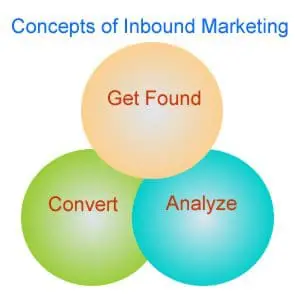In the past week, I’ve been asked several times about inbound marketing for the very small businesses that line our streets all over the country. Sure, it’s great to have a business that has 50 employees and $12 million in revenue. . . but many, many small businesses are more the “mom-and-pop” type, with maybe a couple other employees. How do these very small businesses take advantage of inbound marketing to grow their market share, customer loyalty, and revenue?
The concepts of inbound marketing

1. Get Found
Atrracting visitors to your website is the first step. Driving traffic will help reach those who are actively searching for information related to your products and services.
Here are some strategies for getting found:
Blogging. This is our A1 top strategy for getting found. Blogging can increase web lead generation by 67%! If you don’t have a blog, add one to your domain and get started. If you have a blog, post content regularly and often. We recommend you blog at least 3 times a week for best results.
Make sure your blog content is relevant to the needs of your visitors, prospects and customers.
Optimize your website. Use long tail keywords and be sure to use a targeted keyword phrase in the title of every blog post and on every page. Use Hubspot’s Marketing Grader, Google’s Webmaster Tools, or any free tool to check the optimization for each page in your website.
Opt-in Email. Use email lists to spread your content around. Consider a monthly email newsletter, a tip of the week email, or a regular news blast.
Social Media. Use Twitter, Facebbook, LinkedIn, YouTube and others to publish and distribute your content across all the channels where your target audience “lives”.
Local Listings. Get listed on Google Places, Yahoo Local Listings, and more. Use GetListed.org to claim your listings and develop your online profiles. Then extend your reach with listings on Yelp and other referral sites, as well as the Chamber of Commerce and other business sites.
These strategies work to pull people to your website and increase your website traffic. Once they get to your website, what do you want them to do?
2. Convert
When a visitor comes to your website, offer them some valuable information, or a coupon for a special discount, or a how-to guide in your area of expertise. To get this interesting information, the visitor needs to give you their email address (and any other information you want to collect). This “converts” the visitor to a prospect: they are interested enough in your offer to give up their email address.
Some strategic tools for visitor conversion are:
Downloadable content that is valuable to your visitors and prospects.
Targeted Calls to Action on every page of your website to help drive visitors to a landing page that more fully describes the offer and provides a form where they can convert into a prospect.
Effective landing pages where your visitors fill out a simple form and thereby convert themselves into prospects.
Lead nurturing email campaign to continue to build relationships and move your prospects towards a sale.
3. Analyze
Your main goal here is to find the best ways to use all the techniques above to get found online and create new customers.
The key metrics to watch here are:
- Number of website visitors
- Ratio of new prospects to visitors
- Ratio of new customers to prospects.
Set measurable goals for success, and then analyze your website’s performance and be willing to adjust your approaches and solutions based on the actual results you are (or aren’t) getting.
Conclusion
The concepts of inbound marketing, get found, convert, and analyze, are simple to understand. There are a variety of tools and strategies for accomplishing these three things. Of course, not everything can be done at once, and a small business might need some help in getting all the work done to generate new customers from their website.
I’ll talk about each of these areas in more detail in future posts of this series.
Meanwhile, if you need help understanding how inbound marketing could apply to your company, and increase your revenue, please contact us! We’d be happy to spend 30 minutes with you, reviewing your website and helping you understand where the “low-hanging fruit” is generating more revenue. Our customers typically see and increase in new web-generated leads within 30 days.
